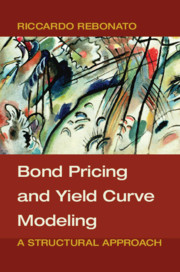Book contents
- Frontmatter
- Dedication
- Contents
- Acknowledgements
- Symbols and Abbreviations
- Part I The Foundations
- Part II The Building Blocks: A First Look
- Part III The Conditions of No-Arbitrage
- Part IV Solving the Models
- Part V The Value of Convexity
- Part VI Excess Returns
- 23 Excess Returns: Setting the Scene
- 24 Risk Premia, the Market Price of Risk and Expected Excess Returns
- 25 Excess Returns: Empirical Results
- 26 Excess Returns: The Recent Literature – I
- 27 Excess Returns: The Recent Literature – II
- 28 Why Is the Slope a Good Predictor?
- 29 The Spanning Problem Revisited
- Part VII What the Models Tell Us
- References
- Index
24 - Risk Premia, the Market Price of Risk and Expected Excess Returns
from Part VI - Excess Returns
Published online by Cambridge University Press: 25 May 2018
- Frontmatter
- Dedication
- Contents
- Acknowledgements
- Symbols and Abbreviations
- Part I The Foundations
- Part II The Building Blocks: A First Look
- Part III The Conditions of No-Arbitrage
- Part IV Solving the Models
- Part V The Value of Convexity
- Part VI Excess Returns
- 23 Excess Returns: Setting the Scene
- 24 Risk Premia, the Market Price of Risk and Expected Excess Returns
- 25 Excess Returns: Empirical Results
- 26 Excess Returns: The Recent Literature – I
- 27 Excess Returns: The Recent Literature – II
- 28 Why Is the Slope a Good Predictor?
- 29 The Spanning Problem Revisited
- Part VII What the Models Tell Us
- References
- Index
Summary
A common mistake that people make when trying to design something completely foolproof is to underestimate the ingenuity of complete fools.
– Douglas Adams, Mostly HarmlessTHE PURPOSE OF THIS CHAPTER
In this chapter we tease out some of the consequences of the dry definitions provided in the previous chapter. In particular, we
prove that if ‘forward come true’ then the invest-long–fund-short strategy will, on average, reap no profits;
derive an expression for the difference between the market yields and the ‘actuarially expected’ yields;
spell out the precise link between excess returns, the market price of risk and risk premia;
discuss again why looking at the ‘yields-do-not-move’ assumption is interesting and important; and
revisit the distinction between the real-world and the subjective probabilities (this is a topic to which we will return in greater detail in Chapter 28).
What do we mean by ‘actuarially expected yields’? We mean that we take the expectation over (minus) the exponential of the paths of the short rate in the real-world measure. This gives us the ‘virtual’ bond prices that investors would demand if they did not care for risk. From these ‘virtual’ actuarial bond prices (ie, the bond prices that would prevail if investors did not care about risk) we derive ‘virtual’ actuarial yields, which we can compare with the market (Q-measure) yields.
Understanding of all this will put us in good stead to discuss the literature that we present in the remaining chapters of this part of the book.
DECOMPOSING AND INTERPRETING THE APPROXIMATE EXCESS RETURNS
The ‘Carry’ Description
If we discretize the results obtained at the end of the previous chapter we see that the realized (approximate) excess return can be decomposed as follows:
Looking at the last line, we find two familiar terms.
The first term is the change between the time-t n-year yield and the value of the (n - 1)-year yield at time-(t + 1), all multiplied by the (n - 1) duration. It is the roll-down term.
- Type
- Chapter
- Information
- Bond Pricing and Yield Curve ModelingA Structural Approach, pp. 431 - 448Publisher: Cambridge University PressPrint publication year: 2018
- 1
- Cited by



